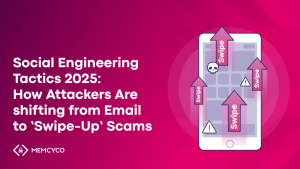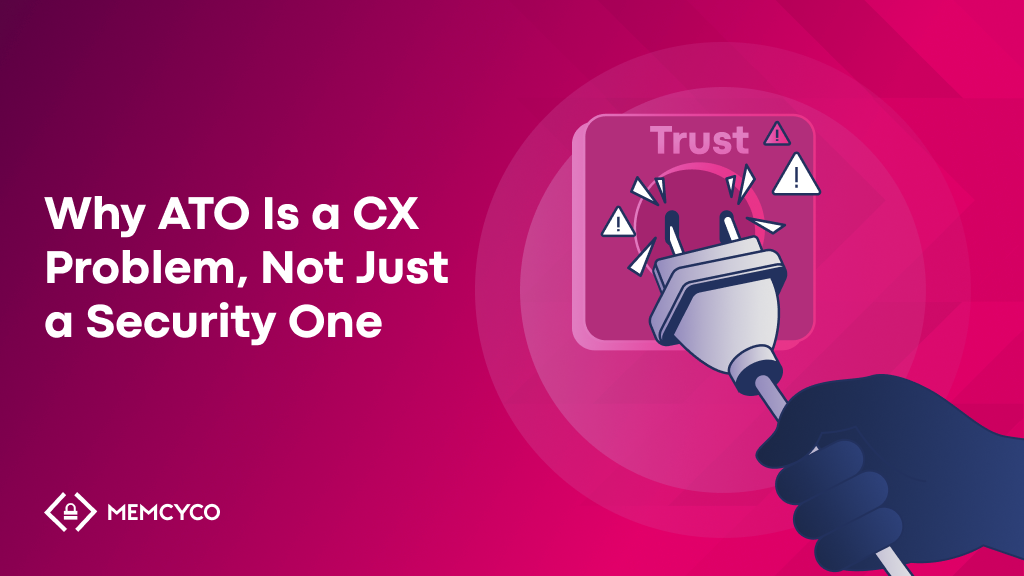Note: Classic clickjacking typically targets authenticated users on legitimate sites, while this article explores its broader use in redirect-based impersonation scenarios.
Clickjacking is a UI redress attack that tricks users into clicking hidden elements, often redirecting them to spoofed landing pages that impersonate trusted brands. Once dismissed as a browser quirk, it is now a silent bridge between user interaction and large-scale brand impersonation campaigns. While traditionally used against authenticated sessions, modern attackers also repurpose clickjacking tactics to funnel users into impersonation flows.
While security teams focus on account takeovers and credential theft, clickjacking and hidden redirects operate upstream, quietly diverting legitimate sessions toward fraudulent sites that look identical to the real one. Traditional controls like Content Security Policy (CSP) and X-Frame-Options cannot see that transition. Memcyco can.
Why Clickjacking Still Matters
Clickjacking may sound dated, but it is thriving in new forms. Modern attackers embed malicious iframes into legitimate web pages or emails, disguising invisible buttons beneath trusted UI elements. A single click can:
- Trigger a hidden redirect to a cloned version of your website.
- Authorize a malicious action such as account linking without the user realizing.
- Feed behavioral data into larger phishing or spoofing chains.
From the user’s perspective, nothing seems amiss. The site looks right, the flow feels normal, and no antivirus alert fires. That is exactly what makes it valuable to impersonators.
The Hidden Redirect Problem
A hidden redirect occurs when attackers manipulate browser events or injected scripts to push users to another domain, often within milliseconds. These redirects can be chained across multiple intermediary URLs, from compromised blogs to temporary CDN mirrors, masking the final destination: a spoofed landing page harvesting credentials or payment data.
Security logs rarely capture this path. Traditional defenses inspect traffic after the redirection has occurred, missing the critical “in-motion” visibility that reveals how and where users were lured.
How Clickjacking and Hidden Redirects Enable Brand Impersonation
To impersonate a brand convincingly, attackers must do more than just copy logos and colors. They need seamless, believable entry points, and that is where clickjacking and redirect chains excel.
- Trust hijacking: A user clicks a genuine link or button, unknowingly launching a hidden redirect.
- Silent diversion: The redirect loads a cloned page that mirrors the original site’s structure.
- Deception in action: The fake site captures credentials, card data, or login tokens.
- Brand damage: Victims blame the legitimate brand for the compromise.
These attacks effectively merge social engineering with technical misdirection, making them invisible to most conventional monitoring tools.
Why Traditional Controls Fall Short
Traditional anti-framing and redirection controls work well in static web architectures but break down in today’s dynamic web app environments. Modern frameworks like React, Angular, or Vue often generate content dynamically and rely on complex third-party integrations. This flexibility introduces blind spots: frame-ancestors and CSP headers can prevent simple iframe-based clickjacking but cannot account for the asynchronous scripts, API-driven redirects, or embedded widgets that load outside the initial DOM. For example, a single misconfigured payment gateway or analytics tag can reintroduce redirect paths even when core pages are protected. Similarly, CSP headers may be bypassed when third-party components request external assets dynamically, creating new attack surfaces that were not present during initial policy setup. These real-world inconsistencies make traditional defenses reactive and brittle in multi-tenant, script-heavy applications.
Headers such as X-Frame-Options and CSP frame-ancestors can prevent basic iframe embedding, but they do not cover:
- Redirects initiated through JavaScript or compromised third-party scripts
- Clickjacking chains that occur outside the original domain
- Phishing pages built from cloned source code rather than embedded frames
Even advanced web application firewalls see only fragments of these behaviors. None correlate redirect origin, path, and impersonation destination in real time.
Related reading: Replace Outdated Phishing Protection With Real-Time Defense
How Memcyco Detects Redirect and Cloning Behavior in Real Time
Memcyco’s preemptive cybersecurity solution closes that visibility gap by detecting redirect-driven impersonation activity directly from the genuine website, before users are exposed or credentials stolen.
- Clickjacking Attempt Detection: Identifies unauthorized iframe overlays or hidden UI layers designed to trigger invisible clicks or redirects.
- Low-Reputation Referral Detection: Flags sessions arriving from suspicious or previously unseen domains, exposing malicious redirect sources.
- Website Cloning Detection: Detects when attackers replicate or partially clone legitimate pages, signaling that a redirect chain leads to an impersonation site.
- Page Tampering Detection: Reveals injected scripts or altered page elements, indicating that a redirect or iframe has modified legitimate content in transit.
Together, these capabilities provide real-time visibility into redirect events and cloned-site activity at the browser level, without monitoring post-login or in-session behavior.
If relevant to search manipulation or phishing exposure:
- SEO Poisoning Defense: Prevents fake redirect pages from being indexed, helping brands contain impersonation campaigns before they escalate.
With this browser-level visibility, organizations can trace redirection paths, identify cloned destinations, and pinpoint individual victims, enabling precise, real-time response.
Related reading: What Is Website Cloning Detection and How It Boosts Your ATO Prevention Strategy
What This Means for Security and Fraud Teams
Beyond operational benefits, these insights also support compliance with global regulations. Visibility into redirect and impersonation activity helps organizations demonstrate proactive defense under frameworks such as PSD2, DORA, and the Singapore Shared Responsibility Framework (SRF). By providing traceable evidence of early detection and customer protection, Memcyco strengthens audit readiness and regulatory alignment across fraud, data integrity, and digital trust mandates.
| Team | Challenge | How Memcyco Helps | Role & Engagement |
|---|---|---|---|
| SOC / InfoSec | Redirects and iframe injections are invisible in standard telemetry. | Receives live alerts and indicators of redirect chains, spoofed domains, and cloned pages through API or SIEM integration. | Continuous monitoring and threat correlation. |
| Fraud / Risk | Redirect-driven impersonation leads to credential theft and false claims. | Gains early insight into which users were redirected and exposed, supporting evidence-based case handling. | Data enrichment for fraud models. |
| Digital Business Teams | Customer sessions hijacked before landing on the legitimate site. | Detects and blocks redirect attempts, preserving trust and conversion funnels. | Active during installation and configuration. |
This collaboration bridges technical detection with business impact, turning obscure web-layer exploits into actionable, customer-centric intelligence.
Real-World Scenarios and Business Impact
Redirect and clickjacking techniques are not theoretical; they repeatedly surface across industries where customer trust is central. The following examples illustrate how these attacks manifest and the resulting consequences.
Banking
Open redirect vulnerabilities often occur when legitimate domains allow unsafe redirects through URL parameters. For example, a customer visiting a valid URL such as:
https://bankingapp.com/login?redirect=https://bankingapp.com/dashboard
can be tricked by a phisher into clicking a modified version:
https://bankingapp.com/login?redirect=https://phishingwebsite.com/fake-dashboard
If the redirect parameter is not validated, the user is seamlessly sent to a fake dashboard that looks authentic, where credentials are stolen. Several online banking phishing campaigns have leveraged this technique, using genuine bank domains to build trust while redirecting users to spoofed destinations.
eCommerce
A 2024 Sucuri analysis documented checkout pages infected with redirect scripts. When customers clicked “checkout,” they were secretly redirected to phishing replicas hosted on external domains. Credit card and PayPal credentials entered there were immediately harvested. This method manipulates legitimate traffic at the critical transaction stage, stealing payment and identity data while users believe they remain on the real store site.
Clickjacking Examples
In online banking, clickjacking can overlay hidden frames on legitimate interfaces. A user attempting to click “View Account Summary” might unknowingly trigger an invisible “Authorize Transfer” button that executes a funds transfer to a criminal’s account. Because the overlay is transparent and precisely aligned, users think they are performing a safe function while executing a fraudulent action.
In eCommerce and advertising, attackers use clickjacking to manipulate ad clicks or initiate hidden transactions. For instance, a transparent payment approval layer can be placed over an interactive banner so that when a user clicks to view a product, they instead authorize a payment or log into a spoofed merchant portal.
| Sector | Attack Type | Typical Manifestation | Primary Impact |
| Banking | Redirect | Phishing redirects using legitimate bank URLs with poisoned query parameters | Credential theft, account takeovers |
| eCommerce | Redirect | Malicious checkout page redirects collecting payment data | Payment fraud, stolen card data |
| Banking | Clickjacking | Invisible frames triggering unauthorized transfers | Fund theft, ATO |
| eCommerce | Clickjacking | Hidden overlays authorizing payments or clicking malicious ads | Unauthorized charges, malware exposure |
Across both industries, these attacks exploit user trust in legitimate interfaces, making them uniquely deceptive and financially damaging. Financial and retail websites now deploy X-Frame-Options headers, CSP framing controls, and strict URL sanitization to mitigate such risks.
Preventing Damage Before It Starts
Clickjacking and hidden redirects are best handled through proactive detection, not post-incident cleanup. Memcyco’s agentless deployment model operates directly from your genuine website code or WAF integration, giving teams instant visibility into impersonation paths without user disruption or plugins.
When a redirect or cloned site is detected, enterprises can:
- Correlate the redirect source and spoofed domain.
- Notify affected customers in real time.
- Launch automated takedowns or deception campaigns to neutralize fake pages.
The result: impersonation attempts are exposed mid-attack, long before they can evolve into account takeovers or large-scale brand damage.
Key Takeaway
Most defenses treat clickjacking as a technical nuisance and redirects as an SEO issue. In reality, they are the entry points of modern impersonation fraud. By observing redirect behavior and cloning activity in motion, Memcyco enables enterprises to see what others miss, and act before trust is broken.
FAQs
1. What is clickjacking in cybersecurity?
Clickjacking is a UI redress attack where hidden frames trick users into clicking actions or links they cannot see, often leading to spoofed or fraudulent websites.
2. How do hidden redirects work?
Hidden redirects use scripts or compromised links to silently send users to another domain, often a cloned or malicious page, without visible indication.
3. How can organizations detect hidden redirects?
By monitoring referral sources and redirect behavior in real time. Memcyco’s referral and cloning detection features identify redirect chains as they happen, exposing impersonation attempts.
4. What is the link between clickjacking and brand impersonation?
Both exploit user trust. Clickjacking creates the invisible click path, and brand impersonation monetizes it by harvesting data on the spoofed destination site.
5. Which tools help prevent clickjacking attacks?
Traditional headers such as CSP and X-Frame-Options help reduce iframe misuse, but advanced detection like Memcyco’s clickjacking and cloning detection reveals the full redirect chain.
6. How does Memcyco protect against redirect-based phishing?
It detects redirect origins, exposes cloned destinations, and provides real-time visibility into individual victim sessions, allowing teams to act before users are compromised.



















